Blogrige
The Official Baldrige Blog
Learning from Role Models: Category 4: Measurement, Analysis, and Knowledge Management
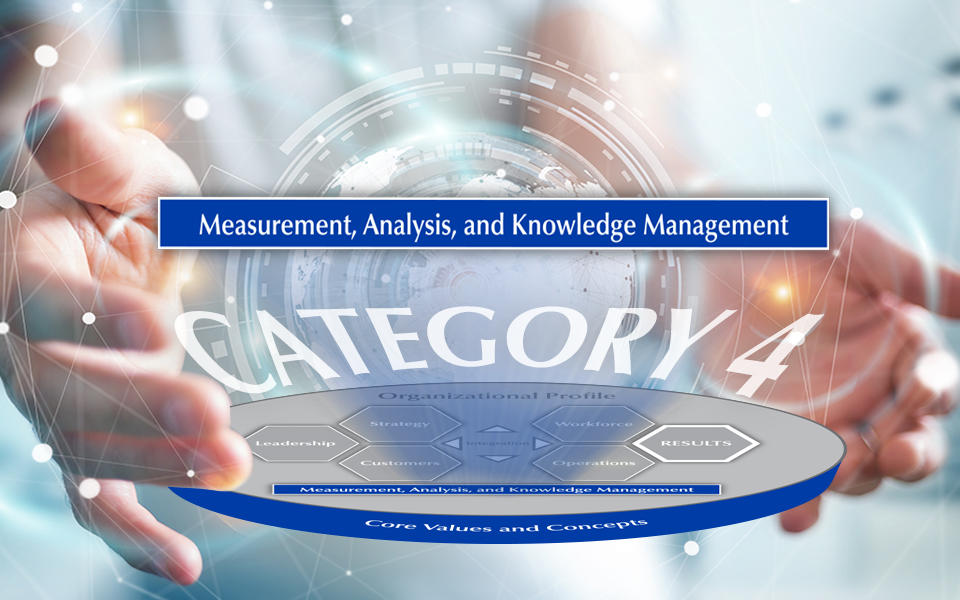
Baldrige Criteria Blog Series
In this blog series, we are highlighting some of the learning (successful strategies and programs) shared by Baldrige Award recipients to highlight the categories of the Baldrige Criteria and how your organization might consider using them as inspiration.
What is Category 4?
Category 4 of the Baldrige Criteria covers all key information on effectively measuring, analyzing, and improving performance, as well as managing organizational knowledge to drive improvement, innovation, and organizational competitiveness.
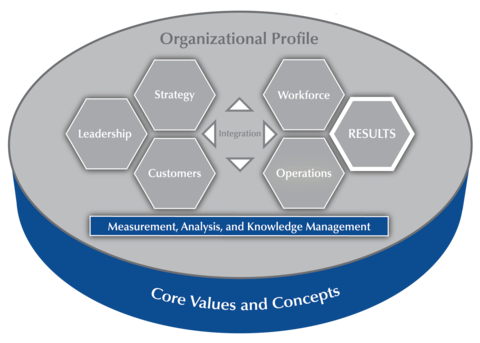
Category 4: Measurement, Analysis, and Knowledge Management
This category asks how your organization uses data and information to improve organizational efficiency and effectiveness and to stimulate innovation. It asks how you select and use data and information to guide your process management. This category also asks how you build and manage your organization’s knowledge assets and ensure the quality and availability of data and information.
Baldrige Award Recipient Best Practices
Following are some practices shared by Baldrige Award recipients (the Center for Organ Recovery & Education, Charter School of San Diego, and Memorial Hospital and Health Care Center) in the realms of selecting and using data for organizational planning and performance improvement, and performance measurement, analysis, and review, as well as to identify best practices. What could your organization learn/adapt?
Center for Organ Recovery & Education (CORE)
2019 Baldrige Award Recipient, Nonprofit
Because industry comparative data were limited, CORE took a lead role in collaborating with two other organ procurement organizations (OPOs)—who were also high-performing Baldrige Award recipients—in creating the Leadership and Innovation National Collaborative (LINC).
LINC meets periodically to define, share, and compare data and best practices. CEOs and COOs from each member organization discuss joint strategies in an effort to enhance OPO industry performance and public perception. In 2018, the LINC executives created two committees--metrics and knowledge management--to share defined, normalized, and comparable data and to develop best practices.
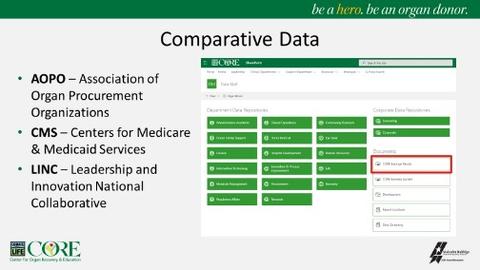
To advance OPOs’ best practices, CORE’s information technology team also worked closely with an industry-wide association to build a tool to examine infrastructure, data, and integration. CORE uses methods such as a leadership-initiated “catch-ball” process that spreads best practices through workforce communication and consensus and a program fostering employee-submitted “Great Ideas.” To identify best practices, CORE participates in local and national associations and collaborates with hospitals and transplant centers.
CORE also gathers industry comparative data through regulatory organizations, accreditors, and customers. In cases where no industry data are available, CORE uses relative and appropriate benchmark data outside of the industry; for example, safety, turnover, information technology responses, and salary surveys have outside industry comparisons.
The organization continuously monitors its performance on key measures through corporate and department-level dashboards, with measures cascading from dashboards and scorecards to action plans. Measures are tracked daily, weekly, monthly, quarterly, and annually using resources such as the “data mall,” which was built in-house by CORE’s information technology staff.
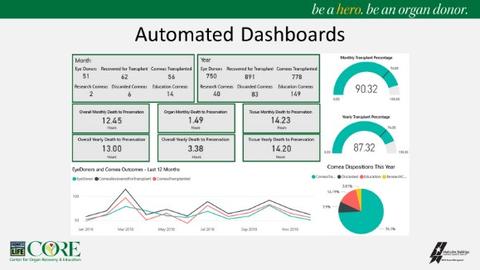
Reports and dashboards in the CORE data mall require validation and sign-off. All data extracts are centralized to ensure that values are consistently used across reports and that data are current. This approach allows CORE to have great agility. For example, in 2017, the Centers for Medicare and Medicaid Services changed the way it measured transplanted lungs and partial liver transplants. CORE was able to rapidly change its own measurements and reporting.
To project its future performance, CORE uses predictive analytics of historical data and external benchmarks and trend data. For example, the clinical department uses linear regression models to forecast the number of organs recovered, a key strategic measure. The human resources department uses a forecasting model to maintain optimal workforce skills and capacity; this model has been continuously improved to address the challenge of daily fluctuations in staffing needs for CORE’s uniquely reactive industry.
Charter School of San Diego (CSSD)
2015 Baldrige Award Recipient, Education
To engage students and reduce dropout rates, CSSD brings together students, parents, teachers, counselors, and support staff to deliver learning through Pathways Personalized Education Plans (PPEPs). PPEPs are used to determine what educational programs and support to provide students by drawing on data and information, including from local school districts, surveys, community demographics, students’ short- and long-term goals, learning styles, current interests, academic achievement, and skills development. Through meetings and data reviews, teachers monitor changes in students' needs and work with learning leads to connect students and families to local resources.
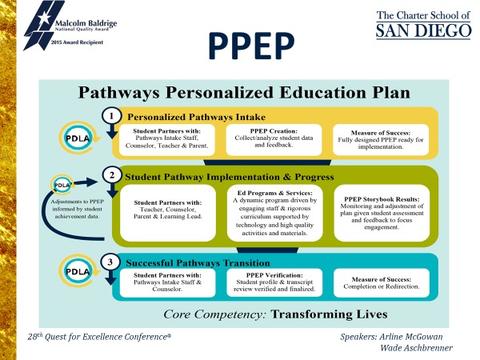
Broken into three phases, PPEPs help students advance academically:
- Personalized Pathways Intake. Students’ PPEP creation begins during enrollment. A support staff member personalizes students’ individualized academic plans by collecting and analyzing information. Assigned teachers consider inputs to assign and develop personalized courses that are delivered through a blended, online independent study educational program. Teachers also work closely with families to set personal and academic goals, as well as to align resources.
- Student Pathways Implementation and Progress. Students and parents work with their teachers in one-on-one and small group settings. Each student’s PPEP is enhanced with field trips, volunteer opportunities, cultural events, guest speakers, career days, elective course options, and work experience customized to student interest and pathway choice. The online student and parent portal allows students and parents to access course assignments and grades at any given time.
- Successful Pathways Transition. Based on their preferences, students are either redirected to traditional high schools or graduate based on accomplishment of their PPEP goals. All students complete an exit survey to identify best practices and opportunities for improvement.
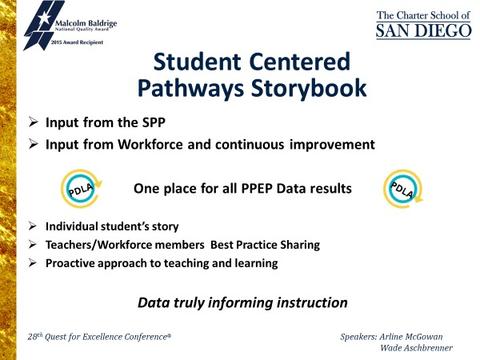
The PPEP Storybook provides a single source for reviewing all pertinent student outcome results. Examples of PPEP Storybook reports include student demographic reports, new student data reports, student participation reports, student confidence survey results, graduate data, student achievement results, dropout data, retention and redirection reports, and key customer survey results. Data are segmented by school, region, resource center, and individual teacher. Several results from the PPEP Storybook are also reflected in the instructional staff scorecard.
PPEP Storybook data are reviewed and analyzed to ensure that instructional strategies are successful for each student. Teachers can immediately reconcile and adjust students’ instruction, methods of delivery, and resources. Teachers and staff conduct home visits, perform and track appropriate interventions, and refer students and families to specific community resources and partnerships.
Through monitoring of PPEP Storybook results and teacher scorecards, the organization learns about and identifies best practices and high performance. These best practices and high performers are held up as role models.
Memorial Hospital and Health Care Center (MHHCC)
2018 Baldrige Award Recipient, Health Care
At MHHCC, data and information used for tracking daily operations and overall organizational performance are selected, collected, aligned, and integrated through the Performance Measurement Process (PMP), which is aligned with the plan, do, check, act, and evaluate process. Performance measurement supports data-driven decision making and the effective performance of key work systems, leadership and governance, access to care, delivery of care, transition to care, and support.
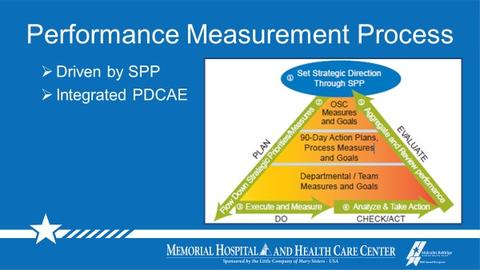
In PMP step 1, leaders set organizational direction and establish Covenant Goals (strategic objectives); all subsequent measures are aligned to these goals. Measures are tracked on the organizational scorecard and through quarterly business reviews. In step 2, strategic objectives flow to 90-day action plan measures, and to processes and departments to ensure alignment. Measures and appropriate comparisons are defined for each 90-day action plan.
In PMP step 3, 90-day action plans and daily operations are executed, and performance is measured. In step 4, results are analyzed, including analysis of organizational scorecard metrics, progress on 90-day action plans, and departmental or process performance. In Step 5, performance on measures is systematically aggregated and reviewed through the Operational Rhythm.
The Operational Rhythm is a structured, multi-tiered framework for reviewing organizational performance and capabilities. Performance is assessed using a balanced set of measures; performance results are analyzed to provide information for decision making; and improvement plans are developed and implemented when objectives are not met. As part of the Operational Rhythm, performance gaps are identified and compared to goals, competitors, or benchmarks.
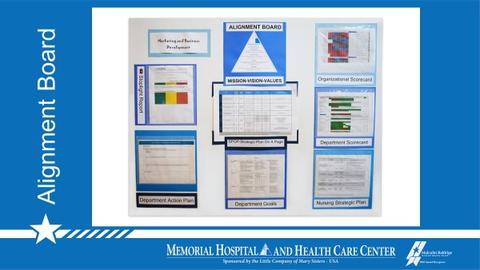
In a 2018 improvement, alignment boards were deployed in each department. They display the organization’s mission, vision, and core values; strategic plan on a page; nursing strategic plan; organizational scorecard; department strategic challenge; stop light reports from senior leaders visiting each department and the front-line (i.e., rounding); and action plans.
MHHCC expands service offerings by acting on market intelligence gathered via techniques such as patient and family advisory councils, analysis of third-party data, and the website and diverse social media tools. Leveraging this intelligence, MHHCC introduced a new stroke telemedicine product; gained insight into an opportunity for secondary market entry that included the need to provide services to the Amish community; and targeted the expansion of the oncology service line.
High-performing units submit best practices electronically to the Hospital Update Board (HUB). After an idea is submitted, best practice team members review and determine if the idea is a “best” practice or a “recommended leadership” practice. Identified best practices/recommended leadership practices are presented at leadership meetings along with action plans for their deployment. Additionally, best practices are captured through 90-day action plan weekly report outs, leadership rounding, the Nursing Clinical Practice Council, and other updates.
Continue Learning Best Practices from Baldrige Award Recipients
- Attend the Baldrige Fall Conference, October 21-22, 2020, Milwaukee, WI
- Join us for the 32nd Quest for Excellence Conference, April 11-14, 2021, National Harbor, MD
- Explore Baldrige Award Recipient Application Summaries to learn how recipients addressed the Criteria questions
Baldrige Criteria Blog Series: Previous Blogs
Category 1: Leadership
Category 2: Strategy
Category 3: Customers
Category 5: Workforce
Category 6: Operations
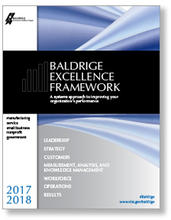
Baldrige Excellence Framework
The Baldrige Excellence Framework has empowered organizations to accomplish their missions, improve results, and become more competitive. It includes the Criteria for Performance Excellence, core values and concepts, and guidelines for evaluating your processes and results.
Purchase your copy today!
Available versions: Business/Nonprofit, Education, and Health Care






Dawn Bailey, I am forever indebted to this awesome and contious improvement program. It is the simplicity and yet Comprehensive nurture in this document which a best seller. The exciting part is that each organisation brings a unique perspective to the same criteria/category in knowledge enrichment.